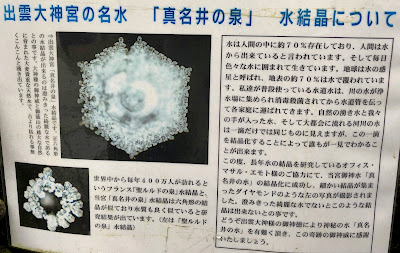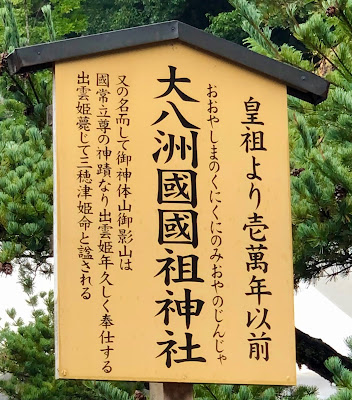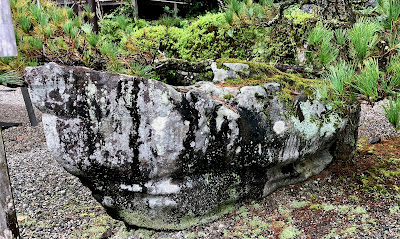 |
| 関西旅行 神戸・美山 : 2022年10月16日~19日 このセクションは、主に '出雲大神宮' についてです。 (参拝) 出雲大神宮 ・住所: Kobe・Miyama: 16th ~ 19th of October, 2022 This section is mainly about 'Izumo Daijingū Shrine'. |
目次 / Contents
1) 一の鳥居 / First Torii Gate
2) 手水舎 / Chōzu-ya
3) 夫婦岩 / Meoto-Rock
4) 大国・恵比須舎 / Daikoku Ebisu-hall
5) 真名井のいずみ / Manai's Spring
6) 拝殿及びその周囲 / Worship Hall and Surroundings
A. 狛犬 / Komainu : Lion-dogs
B. 拝殿 / Worship Hall
1) 一の鳥居 / First Torii Gate
 |
| 一の鳥居 '千年宮鳥居' (センネン ノ ミヤ トリイ) が、2014年にできたので、 実質上は二の鳥居です。 神宮としては、'一の鳥居' の名を残しています。 Ichi-no-Torii : First Torii Gate Since 'Sennen no Miya Torii Gate' : 'Millennium Shrine Gate' was built in 2014, this is actually 'Ni-no-Torii' : 'Second Torii Gate. Here in the Daijingū Shrine, the name of 'Ichi no Torii' : 'First Torii Gate' remains. |
My friend M, who lives in Osaka, picked up another friend Izu and I in front of Shin-Osaka Station in her car, and we headed for Izumo Daijingū Shrine.
(Official Website:★ only in Japanese)
It was raining on this day.
About 'To the Ichi-no-Torii : the first gate, below.
 |
| 境内マップ / Precinct Map 画像は下記より / This from below ★ |
2) 手水舎 / Chōzu-ya
一の鳥居をくぐると、右手に、手水舎 (チョウズヤ/ テミズヤ)、夫婦岩 (メオトイワ)、 大国・恵比須舎 (ダイコク・エビスシャ)、'真名井 (マナイ) のいずみ' と並んでいます。
左手には社務があります。
身を清めるというのが手水舎の目的です。
基本、交互に手を洗い、口を濯ぎます。
以前は柄杓が用いられていましたが、コロナ後は、柄杓がないところが多いと思います。
最近、私は手は洗いますが、口はすすぐふりです。
 |
| 手水鉢の龍 多くの手水舎で龍が用いられています。 龍好きの私は嬉しい! 手水舎全体の撮影はしませんでした。 Chōzubachi Dragon Dragons are used in many chōzu-ya. As a dragon lover, I am happy! I didn't photograph the entire chōzu-ya. |
Chōzu-ya
After passing through the Ichi-no-Torii : First Torii Gate, you will find Chōzu-ya, Meoto - Rock : Married Couple Rock, Daikoku Ebisuya, and Manai no Izumi : Manai Spring on your right.
The office is on the left.
The purpose of a chōzu-ya is to purify oneself.
Basically, take turns washing your hands and rinsing your mouth.
In the past, a ladle was used, but after the corona pandemic, many places do not have a ladle.
Recently, I wash my hands, but I pretend to rinse my mouth.
According to Wiki about Chōzu-ya,
"Chōzu-ya or temizu-ya (手水舎) is a Shinto water ablution pavilion for a ceremonial purification rite known as temizu or chōzu (手水, lit. 'hand-water').
The pavilion contains a large water-filled basin called a chōzubachi (手水鉢, lit. 'hand water basin').
At shrines, these chōzubachi are used by worshippers for washing their left hands, right hands, mouth and finally the handle of the water ladle to purify themselves before approaching the main Shinto shrine or shaden (社殿).
This symbolic purification is normal before worship and all manned shrines have this facility, as well as many Buddhist temples and some new religious houses of worship. "
 |
| 日本の龍は、アニミズムからくる神様 (精霊) の印象が私には強いです。 日本神話は、アニミズムと入り混じっていますよね。 神代 (カミヨ) 後に、仏教が伝来し、神道は、 この仏教と馴染んできました。 現在では神仏習合 (シンブツシュウゴウ) が多くの場面、場所で見られます。 手水舎もそれらが見られる場所であると思います。 I have a strong impression of Japanese dragons as Gods (spirits) from animism. Japanese mythology is mixed with animism, isn't it? After the Age of the Gods, Buddhism was introduced, and Shinto has become familiar with this Buddhism. Today, Shinbutsu-shūgō can be seen in many scenes and places. I think the chōzu-ya is also a place where you can see them. |
According to Wiki about Shinbutsu-shūgō,
"Shinbutsu-shūgō (神仏習合, "syncretism of kami and buddhas"), also called Shinbutsu shū (神仏宗, "god buddha school") Shinbutsu-konkō (神仏混淆, "jumbling up" or "contamination of kami and buddhas"), is the syncretism of Shinto and Buddhism that was Japan's main organized religion up until the Meiji period. Beginning in 1868, the new Meiji government approved a series of laws that separated Japanese native kami worship, on one side, from Buddhism which had assimilated it, on the other."
3) 夫婦岩 / Meoto - Rock
行きの段階では気がつきませんでしたが、なぜか、出雲大神宮は、敷地内にたくさんの岩にしめ縄がかけられ、祀っていました。
御蔭山 (ミカゲヤマ) の山麓に出雲大神宮はあります。
もともと御蔭山を神体山 (シンタイサン) として祀る信仰がありました。
山の一部がなんらかの理由で、岩として独立したものを処分せず、そのまま祀っているのではないかと推測します。
夫婦岩と名付けられた岩もその1つだと思います。
 |
| 夫婦岩 : ★ 大神宮のサイトに由来の説明はありません。 この大神宮は、縁結びのご利益があるとされているので、 設置された岩と推測します。 Meoto - Rock : Married Couple Rock There is no explanation of the rock origin in the website of the Daijingū. This Daijingū Shrine is said to benefit marriage, so I guess that is why this rock was installed. |
Meoto - Rock
'Izumo Daijingū Shrine enshrines Ōkuninushi : Ōkuninushi no Ōkami and his wife Mihotsuhime no Mikoto (or Mihotsu-hime :
a Goddess), and for this reason the shrine is known for blessings of matchmaking.
I didn't notice it when I was on my way there, but for some reason, Izumo Daijingū Shrine had many rocks with shimenawa ropes attached to them.
Izumo Daijingū Shrine is located at the foot of Mt. Mikage
Originally, there was a belief that Mt. Mikage was worshiped as a Sacred Mountain.
I speculate that for some reason if part of the mountain falls down they enshrine each rock as they have fallen.
I think the rock named 'Meoto-Rock : Married Couple Rock' is one of them.
 |
夫婦岩 岩の説明はサイトにありませんが、 '縁結び'のお参りの方法についての説明はあります。 夫婦岩について、サイトより。 "当宮の縁結びの御守には赤い糸が付いています。 御守は常に身につけ、赤い糸を夫婦岩のまわりに結んでください。 神さまが幸せなご縁を結んで下さるでしょう。" 五円玉と赤い糸が岩の周りにたくさん吊るされています。ちょっと胡散臭さを感じるのは、私だけでしょうか? Meoto - Rock : Married Couple Rock There is no description of the rock origin on the website, but there is instruction on how to pray for 'matchmaking'. According to the Shrine website, about the Rock, (Translated by me) "There is a red thread attached to the amulet of matchmaking in this shrine. Please always wear the amulet and tie the red string around the Meotoiwa rock. The God will give you a happy relationship. " Many five-yen coins and red threads are hung around the rock. Am I the only one who feels a little dubious? |
According to Wiki about the five-yen coins,
"The Japanese for "five yen," go en (五円) is a homophone with go-en (御縁), "en" being a word for causal connection or relationship, and "go" being a respectful prefix."
4) 大国・恵比須舎 / Daikoku Ebisu-hall
 |
右 :夫婦岩 左:大国・恵比須舎 夫婦岩と並んで、大国・恵比須舎があります。 Right : Meoto-Rock : Married Couple Rock Left : Daikoku & Ebisu-hall Along with Meoto-Rock, there is a Daikoku & Ebisu-hall. Daikoku is Ōkuninushi who is enshrined by this Shrine. and also is one of the Seven Gods of Fortune. |
 |
| 大国・恵比須舎 : ★ 大国・恵比須舎は、'千年宮鳥居' や' 社号標石碑' 同様、 社殿創建千三百五年を記念して建立されました。 大国 (大国主) 像と恵比須 (エビス) 像が設置されています。 縁結びの神・大国主さまと商売繁盛の神・恵比寿さまが 並んで祀られているという、 参拝者にとって都合の良い舎ですね。 This Hall was erected as a 'commemorative project for the 1305th anniversary of the construction of the shrine' just like 'Sennen no Miya Torii Gate' : 'Millennium Shrine Gate' and the 'Shrine Name Stone Monument'. Statues of Ōkuninushi and Ebisu are set up. Ōkuninushi, the God of marriage, and Ebisu, the God of prosperous business, are enshrined side by side making this a convenient hall for many worshipers.  |
5) 真名井のいずみ / Manai Spring
 |
| 真名井のいずみ この泉は、'真名井のいずみ'と呼ばれています。 現在では、'神話の真名井の水' (後述)をもとに、 '真名井の水'とは、最も清浄な湧き水を讃える 最上級の敬称になっています。 Manai-no-Izumi : Manai Spring This spring is called Manai-no-Izumi. Today, based on the myth (later mention : Mythical 'Water of Manai), 'Water of Manai' has become the highest honorific title for the purest spring water.  |
<神話の真名井の水>
地上には、純粋な水がなかったので、天児屋命は、息子の
天押雲命 (アメノオシクモノミコト) :
天牟羅雲命 (アメノムラクモノミコト) を高天原へ遣わせ、報告させました。
(真名井の水の伝承のなかでは、天牟羅雲命の名が用いられています)
天照大御神は、天忍石長井之水 (アメノオシハガノイノミズ)を八杯、玉鋺 (タママリ) に入れ、天牟羅雲命に地上へ運ばせ、神々の食用と飲み水にさせ、残りを地の水に注がせました。
その水が、'真名井の水'と呼ばれ、天牟羅雲命は日本の井戸の神様になりました。"
<Mythical 'Water of Manai' >
"At the time of Tenson-kōrin, one of the five Gods who followed Ninigi no Mikoto was Ame-no-Koyane-no-mikoto.
[According to. Wiki about Tenson-kōrin,
"In Japanese mythology, the tenson kōrin (天孫降臨) is the descent of Amaterasu's grandson Ninigi-no-Mikotofrom Heaven (Takamagahara) to Ashihara no Nakatsukuni; according to legend, the direct place of descent is at Takachiho-gawara in Japan)"]
Since there was no pure water on earth, Ame-no-Koyane-no-mikoto sent his son Ame-no-mura-kumo-no-mikoto to report to Takamagahara.
(Ame-no-mura-kumo-no-mikoto : Ame-no-mura)
Amaterasu put eight cups of Takamagahara pure water, and had Ame-no-mura carry it to the ground to be eaten and drunk by the Gods, and pour the rest into the water of the earth.
The water was called 'Water of Manai', and Ame-no-mura became the God of Wells in Japan. "
真名井のいずみ
Manai-no-Izumi : Manai Spring
 |
| 説明と賽銭のお願い Explanation and Request for Offerings |
<出雲大神宮の真名井の水>
(下記、'大阪朝日新聞 昭和60年12月26日付' より/ 大神宮のサイトから)
"日本水質保健研究所によれば、古生代の石灰岩層をつたって火山噴火でできたマグマの接触変成岩層から湧き出ている「うまい水」で、ミネラルがバランスよく含まれる極めて健康によい理想の水であるとするなど地質学的に実証されております。
このような水は自然界の中でもほんの一部しか存在しないという事です。"
このような水は自然界の中でもほんの一部しか存在しないという事です。"

<Water of Manai in Izumo Daijingū Shrine >
(From 'Osaka Asahi Shimbun dated 26th of December ,1985' / Daijingū website)
(translated by me)
"According to the Japan Water Quality and Health Research Institute,
this is ideal water with a good balance of minerals and extremely good for health and is "delicious water" that springs out from metamorphic rock layers of magma formed by volcanic eruptions through limestone layers of the Paleozoic Era.
It is geologically proven that water like this is only available in a small part of the natural world. "
6) 拝殿及びその周囲
Worship Hall and Surroundings
A. 狛犬 / Komainu : Lion-dogs
 |
| 左手前 : 吽形 (ウンギョウ) の狛犬 中 : 拝殿 右手前 : 阿形 (アギョウ) の狛犬 Front Left : Un's Komainu (closed mouth) Middle : Worship Hall Front Right : A's Komainu (open mouth) |
ここでは、阿吽形の狛犬 (コマイヌ) が用いられています。
下記、阿吽についてWikiより
"阿(あ)・吽(うん)の形は日本で多く見られる特徴であり、仁王像と同様、日本における仏教観を反映したものと考えられている。"
狛犬は、神社、寺院に用いられ、神仏習合の日本文化が感じられます。
 |
| 吽形の狛犬 / Un's Komainu |
Here, A-un shaped Komainu : Lion-dogs are used.
"The term is also used in Buddhist architecture and Shinto to describe the paired statues common in Japanese religious settings, most notably the Niō (仁王) and the komainu (狛犬).
One (usually on the right) has an open mouth regarded by Buddhists as symbolically speaking the 'A' syllable; the other (usually on the left) has a closed mouth, symbolically speaking the 'Un' syllable.
The two together are regarded as saying 'A-un'.
The general name for statues with an open mouth is agyō (阿形, lit. 'a' shape), that for those with a closed mouth ungyō (吽形, lit. "un' shape") "
Komainu : Lion-dogs are used in shrines and temples, and I can feel the Japanese culture of Shinbutsu-shūgō.
 |
阿形の狛犬 / A's Komainu  |
B. 拝殿 / Worship
 |
| 拝殿 1878年政府によって造営されました。 Built by the government in 1878. |
 |
| 拝殿と本殿 手前が拝殿、奥が本殿です。 一般参拝者は、本殿までゆくことはできません。 Worship Hall and Main Hall The front is the worship hall, and the back is the main hall. General worshipers cannot go to the main hall. |
 |
| 本殿・横から Main Hall from the Side 画像は下記より / This from below ★ |
 |
| 本殿 国の重要文化財 Main Hall Japanese National Important Cultural Property 画像は下記より / This from below ★ |
次のセクションは、御蔭山含む境内散策についてです。
The next section is about walking around the precincts, including Mt. Mikage.




0 件のコメント:
コメントを投稿